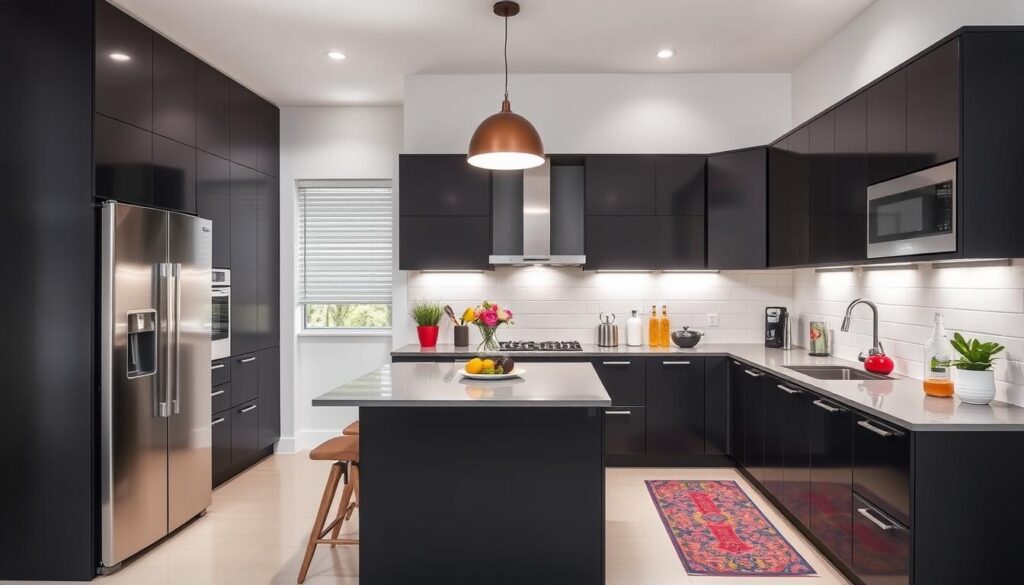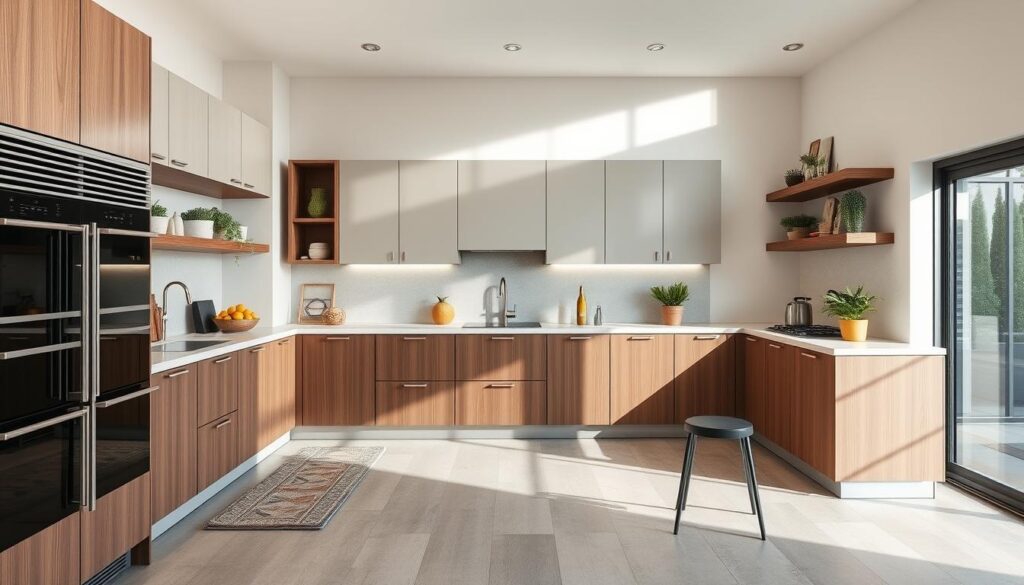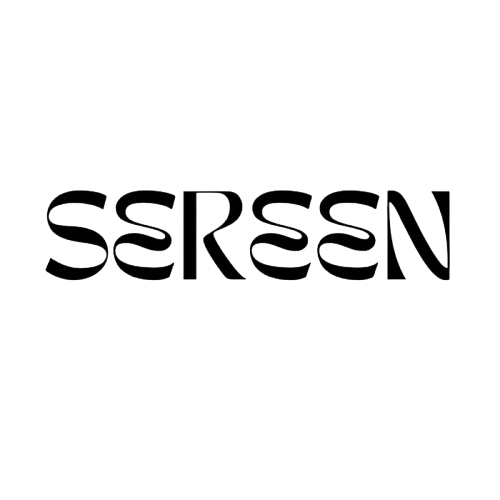Starting to design your dream kitchen raises a key question: what are the must-knows to make it both stunning and practical? We’ll walk you through the crucial planning steps. This includes measuring your space, picking the right materials, and planning storage and tech. You’ll get valuable tips for designing your kitchen.
Knowing the basics of kitchen design is vital. It involves a good layout, the right materials, and functional elements. By following our guide, you’ll create a kitchen that’s perfect for you. You’ll use effective tips to make it happen.
Key Takeaways
- Measure your available space to determine the best layout for your kitchen
- Select materials and finishes that are both durable and aesthetically pleasing
- Plan your kitchen storage solutions to maximize efficiency and functionality
- Incorporate modern kitchen technologies to enhance your cooking experience
- Consider the importance of a well-planned layout in your kitchen design
- Use kitchen design tips to create a functional and beautiful kitchen
- Understand the essential things you must know before designing your kitchen to ensure a successful project
Understanding Your Kitchen Space and Layout Basics
When planning your kitchen layout, the first step is to measure your space. This is key to creating a kitchen that is both functional and looks good. We need to know how much room we have for furniture and appliances.
There are many kitchen layouts to choose from, like L-shape, U-shape, and island layouts. Each has its own benefits. For example, an L-shape layout is great for small kitchens because it saves space. A U-shape layout gives you more counter space. An island layout adds storage and seating.
- Measuring the available space to determine the best layout
- Choosing a layout that suits our needs and preferences
- Considering traffic flow to ensure a safe and easy-to-navigate kitchen
By following these tips and considering your space, you can make a kitchen that is both functional and beautiful. It will meet your needs and make cooking more enjoyable.
| Layout Type | Advantages | Disadvantages |
|---|---|---|
| L-shape | Ideal for small kitchens, efficient use of space | Limited counter space |
| U-shape | Provides more counter space, suitable for large kitchens | Can be overwhelming for small kitchens |
| Island | Offers additional storage and seating options, visually appealing | Requires sufficient space, can be expensive |
Things You Must Know Before Designing Your Kitchen
When planning a kitchen renovation, several key factors are important. A realistic budget is essential to know how much we can spend on things like countertops and appliances. Our cooking style and needs also shape the design, affecting the layout and features.
Thinking about how we move around the kitchen is crucial. We need to place items like the sink and stove wisely. This helps us make smart decisions for our kitchen design, ensuring it fits our lifestyle well. Some important things to remember include:
- Determining our cooking style and needs
- Considering the workflow in our kitchen
- Setting a realistic budget
By focusing on these essentials, we can design a kitchen that works well and looks great. As we design, keeping these points in mind will help our kitchen meet our needs and exceed our expectations. 
Considering these essentials helps us create a kitchen perfect for cooking and entertaining. A well-designed kitchen makes our daily lives easier and more enjoyable.
Essential Kitchen Work Triangle Principles
When designing a kitchen, it’s key to think about the kitchen work triangle. This refers to the sink, stove, and refrigerator forming a triangle. This setup makes the kitchen more efficient. It helps you place these elements in the best spots for your needs.
To get the most out of your kitchen, keep these tips in mind:
- Put the sink, stove, and refrigerator in a triangle to cut down on walking and improve flow.
- Make sure there’s enough counter space between each item for a comfortable work area.
- Follow safety and clearance rules to avoid accidents and keep the kitchen safe.
By sticking to these rules and avoiding common mistakes, you can make a kitchen that looks great and works well. It will have the storage you need.
A good kitchen is more than just pretty. It’s about being functional and safe. By using the kitchen work triangle and smart storage, you’ll have a kitchen that’s fun to use and safe for your family.
| Kitchen Element | Optimal Placement | Clearance and Safety Guidelines |
|---|---|---|
| Sink | Between the stove and refrigerator | At least 24 inches of counter space on either side |
| Stove | At least 30 inches away from the sink and refrigerator | At least 12 inches of counter space on either side |
| Refrigerator | At least 36 inches away from the sink and stove | At least 12 inches of counter space in front |
Planning Your Kitchen Storage Solutions
Designing a kitchen often focuses on looks, but storage planning is key. Using trends like vertical storage and smart solutions makes your kitchen both pretty and practical. A well-thought-out storage system keeps your kitchen tidy and organized.
When planning your kitchen storage, consider these points:
- Assess your storage needs: Count the items you need to store, like dishes, utensils, food, and cleaning supplies.
- Maximize space: Use wall shelves, pull-out drawers, and other space-saving ideas to make the most of your kitchen.
- Choose smart storage: Look for solutions with the latest trends, like adjustable shelves and hidden spots.
Planning your kitchen storage well makes it stylish and useful. As we look at new trends, a good storage system is crucial for a great cooking space. 
A well-planned storage system greatly improves your kitchen’s look and feel. By using the latest trends and thinking about your needs, you can have a kitchen that looks good and works well. We’ll keep exploring new trends and how to use them in our kitchen design.
Selecting the Right Materials and Finishes
Choosing the right materials and finishes is key in kitchen design. We look for budget-friendly upgrades that improve our kitchen’s look. The right materials make our kitchen both useful and attractive.
Laminate countertops, stock cabinets, and hardwood flooring are great choices. They balance quality, durability, and cost. For example, laminate countertops are cheaper than granite or marble but offer many styles and finishes.
We also think about maintenance, durability, and eco-friendliness when picking materials. Hardwood flooring is popular for its ease of cleaning and long life. Choosing eco-friendly options like reclaimed wood or bamboo is also a good idea.
Countertop Material Options
- Laminate countertops: a cost-effective alternative to granite or marble
- Granite countertops: a durable and stylish option
- Quartz countertops: a low-maintenance and versatile choice
By comparing different materials and finishes, we make smart choices. With some creativity and planning, we can have a kitchen that looks great and works well. It will show off our personal style and preferences.
Kitchen Lighting Design Essentials
Lighting is key to a functional kitchen. A well-lit kitchen is safe, easy to work in, and looks great. To get this, you need task, ambient, and accent lighting.
Task lighting shines on specific spots, like countertops or sinks. Ambient lighting lights up the whole room. Accent lighting makes certain features stand out, like a kitchen island.
When designing kitchen lighting, remember a few things:
- Layering lighting makes the space look good and work well
- Choose energy-saving lights, like LEDs
- Make sure the lighting is easy to keep up with
By planning kitchen lighting carefully, we can make a space that’s both beautiful and useful. This way, we get the most out of our kitchen.
| Lighting Type | Description |
|---|---|
| Task Lighting | Used to illuminate specific areas, such as countertops or sink |
| Ambient Lighting | Provides overall illumination for the space |
| Accent Lighting | Used to highlight specific features, such as a kitchen island or decorative elements |
Incorporating Modern Kitchen Technologies
When designing a kitchen, think about how technology can improve it. Adding smart appliances and energy-saving features makes a big difference. It turns your kitchen into a beautiful, functional space.
Some key things to consider include:
- Smart appliance integration for easy control and monitoring
- Energy-efficient options like LED lights and eco-friendly appliances to save energy
- Future-proofing your kitchen with adaptable technologies
Future-proofing your kitchen means it stays useful for years. Use technologies like modular designs and smart home systems. It might seem hard, but with some planning, you can make a kitchen that looks great and works well.
By focusing on technology and future-proofing, your kitchen will meet your needs now and later. It will be more efficient, valuable, and appealing.
| Technology | Benefits |
|---|---|
| Smart Appliances | Increased efficiency, convenience, and control |
| Energy-Efficient Solutions | Reduced energy consumption, lower utility bills, and environmental benefits |
| Future-Proofing | Adaptability to future technological advancements, increased kitchen value and appeal |
Budgeting for Your Kitchen Design Project
When planning your kitchen design, budgeting is key. It helps you stay within your means while achieving your design dreams. Start by breaking down costs into materials, labor, and appliances. This way, you can plan your budget wisely and make choices that fit your needs and wallet.
A good budget plan lets you focus on what’s important. You might choose to spend more on appliances but save on countertops or flooring. Knowing your cost breakdown helps you balance your wants with your budget.
- Materials and supplies
- Labor costs for installation and construction
- Appliances and fixtures
- Permits and inspections
With a well-thought-out cost breakdown and budget plan, you can have a kitchen that’s both beautiful and functional. And it will all fit within your budget.
Common Kitchen Design Mistakes to Avoid
When designing a kitchen, it’s key to know the common mistakes to steer clear of. We’ve all seen kitchens that are hard to use or make cooking a hassle. To make a kitchen both pretty and practical, we must watch out for issues like not enough storage, bad workflow, and poor lighting.
Some common errors to dodge include inadequate storage, which can cause clutter. A good kitchen should have enough space for all your kitchen items. Poor workflow is another mistake, making cooking and cleaning hard. A good kitchen should let you move easily between the sink, stove, and fridge.
Here are some common mistakes to avoid:
- Inadequate storage
- Poor workflow
- Insufficient lighting
- Inadequate counter space
- Poor ventilation
By avoiding these common mistakes, we can make a kitchen that works well, is efficient, and looks great. As we design our kitchen, we should remember the importance of common mistakes to avoid. We should aim to create a space that meets our needs and avoids these issues.
By knowing these common mistakes to avoid, we can make a kitchen perfect for cooking, hanging out, and making memories with loved ones.
| Mistake | Consequence | Solution |
|---|---|---|
| Inadequate storage | Clutter and disorganization | Install ample cabinets and shelves |
| Poor workflow | Inefficient cooking and cleaning | Design a workflow that allows for easy movement between the sink, stove, and refrigerator |
| Insufficient lighting | Poor visibility and ambiance | Install adequate lighting, including task, ambient, and accent lighting |
Working with Kitchen Design Professionals
Creating your dream kitchen is easier with professional help. Designers and contractors bring expertise to the table. They ensure your project is done right, on time, and within budget. It’s an investment that avoids mistakes and guarantees quality.
Professionals offer many benefits. They provide expert advice, tailored designs, and manage projects well. Choosing the right contractor and understanding design services is key. This way, your kitchen will exceed your dreams.
- Experience and reputation in kitchen design and renovation
- Clear communication and project management skills
- Ability to understand and meet your unique needs and preferences
With professionals, your kitchen project will be a success. We offer insights and guidance for your decisions.
Choosing the Right Contractor
Finding the right contractor is crucial for your kitchen project. Research and interview potential contractors. Choose one that fits your needs and budget.
Working with a reputable contractor ensures quality and timely completion. It’s a step that makes your project successful.
Conclusion: Creating Your Dream Kitchen
Designing your dream kitchen needs careful planning and a clear understanding of what you want. This article has given you the tools to make your kitchen both beautiful and functional. It will improve your cooking experience every day.
The secret to a dream kitchen is to stay focused and open to new ideas. Enjoy the process of creating your space. With the right mindset and resources, you can make your kitchen a true reflection of you.
Let’s start this exciting journey to make your dream kitchen come true. Whether you’re updating or starting fresh, this guide will help you. Trust your instincts and get ready to love your new kitchen.
FAQ
What are the common kitchen layout types?
Common kitchen layouts include the L-shape, U-shape, and island layout. Each has its own benefits. Choose based on your space and needs.
What are the essential elements of the kitchen work triangle?
The kitchen work triangle involves the sink, stove, and fridge in a triangle. This setup improves workflow. It’s key to have enough counter space and follow safety rules for a functional kitchen.
What are some budget-friendly kitchen upgrades?
Affordable upgrades include laminate countertops, stock cabinets, and hardwood floors. Smart choices can meet your design goals without spending too much.
How can I maximize my kitchen’s storage solutions?
Use vertical storage, pull-out drawers, and smart solutions to boost storage. These trends help keep your kitchen tidy and organized.
What are the common kitchen design mistakes to avoid?
Avoid mistakes like bad storage, poor workflow, and not enough light. Also, don’t forget the kitchen work triangle. Knowing these errors helps create a beautiful and useful kitchen.
How can I work with kitchen design professionals effectively?
Working with design pros can greatly benefit your project. Start by picking the right contractor. Then, understand the services they offer and plan your timeline. This ensures your kitchen is done on time and within budget.




